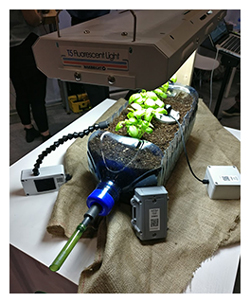IoT sensor kit maintains optimum conditions for tulip bulbs
As part of London Tech Week, Electronic Specifier attended TechXLR8 at London’s ExCeL. We got the chance to meet with 30MHz, a Dutch company that lowers the barrier to entry to industrial sensor technology. The interoperable plug-and-play 30MHz Sensor Toolkit is designed for quick implementation of sensors in the hundreds of thousands, and its dashboard makes data monitoring simple and user-friendly from any device.
Joanna Madej, Product Marketing specialist at 30MHz, explained to us some of the key applications the Sensor Toolkit has been used in.

At the show she explained how the toolkit can help grow better peppers (pictured), and another agricultural application is maintaining optimum temperature for tulip and lily bulbs.
Jan de Wit en Zonen (Jan de Wit and Sons) have specialised in the export, processing and cultivation flowerbulbs since 1922, delivering to clients in more than twenty countries across Europe, Asia and North America. The family business specialises in tulip and lily bulbs, as well as other flower varieties including hyacinths and irises. De Wit and Sons know that delivering flowers of the highest quality is the key to maintaining and expanding their position in the global flower market. Data captured by a variety of wireless sensors provides the company with an advantage: growing and processing each flower variety with precision.
Because each flower variety has different needs, each requires a unique approach. For example, lilies are winter flowers, while tulips and hyacinths are summer products. To make sure they’re delivering the best products to their customers, it’s crucial that De Wit and Sons optimise conditions for the cultivation and export of each flower type.
Monitoring ethylene, air currents and extreme temperatures with wireless sensors
To capture key data on the cultivation, processing and storage of their products, Jan De Wit and Sons installs the 30MHz Sensor Toolkit in strategic locations throughout the organisation. “When the health and quality of our product is at stake, it’s crucial that we have accurate data. We know that sensor placement is very important, so we make sure that each location is technically equipped with a power supply and internet connection” noted Marcel Fit, Deputy Director, Jan de Wit and Sons.
De Wit and Sons capture data on ethylene, temperature and humidity, as well as air currents. Fit explained why these metrics are key to the company’s success: “When it comes to lilies, it’s important that they’re stored in the ice, between -1 and -1,5°C. Lily plants can withstand temperatures of -30°C, but their bulbs are much more vulnerable in storage. Precise temperatures are key. Furthermore, we have to monitor ethylene levels and ensure sufficient bulb drying to lower the risk of bulb rot. We monitor ventilation to make sure bulbs are properly dried after rinsing.”
A combination of sensor types
Using sensor data and real-time alerts, De Wit and Sons keep a close eye on potential threats to their flower bulbs. A continuous flow of information makes it easy to intervene and adjust conditions to prevent product loss. “The ethylene measures ethylene in ppb. The anemometer monitors the air currents blown through the cubicles during the drying process, and the temperature-humidity sensors help us monitor the cooling cells day and night. “
Working with IoT partner 30MHz
“With the 30MHz Sensor Toolkit, we actually measure ethylene, air currents and temperatures below zero. The data is recorded in a clear dashboard that we can easily log into and use. The Toolkit’s notifications are also very important to our business. If conditions change, the responsible staff is aware and can respond straight away.”
With a growing sensor network in the Netherlands, De Wit and Sons plan to take their approach monitoring global: “Looking forward, the next step is customer measurements abroad. We know there are no limitations with the Sensor Toolkit, so our next challenge is guaranteeing accessibility on-site.”







